Periodontal Therapy – Williamstown, NJ
Using the Latest Dental Technology
to Save Your Smile
According to the Centers for Disease Control and Prevention, one out of every two adults in the United States suffers from gum disease. What’s more alarming is that many don’t even realize it. The truth is, while symptoms start off relatively mild, they can quickly progress, leading to bone deterioration, tooth loss, and even complications associated with serious diseases like diabetes and certain cancers. If Dr. Wael Kassem and his team at iSmile Dental Arts discover that you’re suffering from periodontal disease, we can provide personalized options for periodontal therpay in Williamstown, NJ to revitalize your oral health and give you back your happy smile.
Why Choose iSmile Dental Arts
for Periodontal Therapy?
- Gentle and Precise Scaling and Root Planing
- PerioChip Therapy for Targeted Aftercare
- Modern Soft Tissue Laser Therapy Utilized
Symptoms of Gum Disease
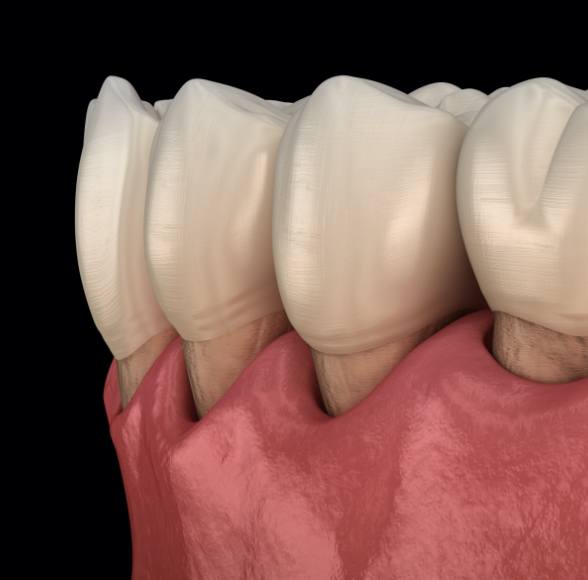
There are two stages of gum disease called gingivitis and periodontitis. Gingivitis is the less severe form of this condition that can be treated and reversed, but advanced periodontitis is harder to control and can ultimately cause permanent oral damage if left untreated. That’s why Dr. Kassem conducts semi-annual checkups where he thoroughly examines your oral tissues for any of the following signs of gum disease:
- Inflamed, swollen, or red gums.
- Bleeding while brushing or flossing.
- Chronic bad breath.
- Receding gums.
- Pockets of bacteria and pus forming between the teeth and gums.
- Pain or discomfort while chewing.
- Loose or shifting teeth.
- Loss of permanent teeth.
At the first sight of any of these symptoms, it’s crucial to contact our dental office right away. We’ll work quickly to develop a customized treatment plan to tackle and reverse the symptoms of gum disease if possible.
Treating Gum Disease
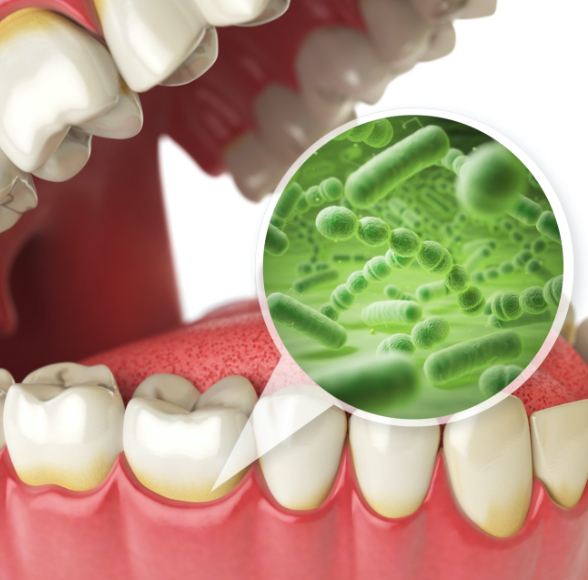
At iSmile Dental Arts, we use the latest technology, techniques, and knowledge to improve our patients’ oral health and preserve their natural smile. When you visit our dental office for treatment, we’ll determine the severity of your case and determine which option below would benefit you the most.
Scaling & Root Planing
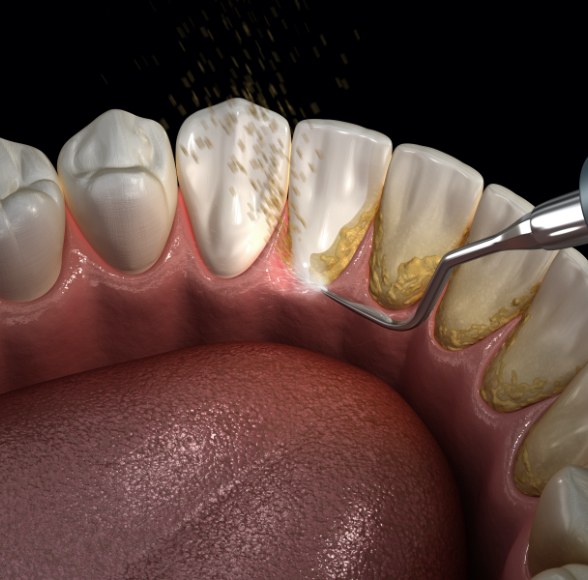
If your body is exhibiting some of the earlier signs of gum disease, we may suggest scaling and root planing, also known as a deep cleaning. This procedure allows us to thoroughly remove all lingering oral bacteria and ease your symptoms. We’ll remove all plaque and tartar from the surface of the roots of your teeth. Then, we will smooth down your roots and allow them to reconnect with your gums, preventing bacteria from having access to the sensitive area and causing tooth infections. Continue reading to learn more about scaling and root planing and how it works.
Do I Need Scaling & Root Planing?
Scaling and root planing is often referred to as a “deep cleaning.” If we notice any signs of gum disease, like bleeding, swelling, and inflammation, we will address it as quickly as we can to prevent it from progressing and resulting in permanent damage to the gums and surrounding structures. The point of this procedure is to remove bacterial buildup around and beneath the gumline before smoothing down the roots to allow the area to heal.
The Process of Scaling & Root Planing
Scaling and root planing takes place over two separate appointments. The first one consists of the “scaling.” This is when we use dental tools to remove plaque and tartar that have accumulated along and beneath the gumline using dental instruments.
Once the scaling portion is complete, we will move on to the root planing portion. At this point, we will smooth down the parts of the teeth that are normally hidden beneath the gum tissue. This allows the gums to adhere to the teeth with ease, making it more difficult for bacteria to build up again. This also reduces your future risk of gum disease.
Aftercare Tips for Scaling & Root Planing
It is common for patients to experience sensitivity of the gum tissue after scaling and root planing treatment. You could also experience some swelling in the area. This is normal and temporary, so it should resolve itself. Here are some tips to help you recover quickly:
- Brush twice daily with a soft-bristled toothbrush
- Use a saltwater rinse after eating
- Floss thoroughly every day
- Stick to a soft-food diet for 48 hours after your treatment
- Avoid spicy, acidic, and hot foods
- Refrain from strenuous activities directly after treatment
PerioChip Therapy
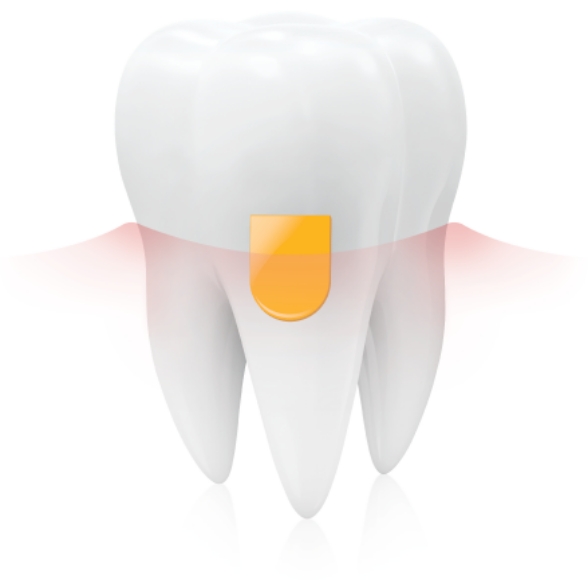
For some patients, we can turn around the effects of gum disease by combining PerioChip therapy with a deep cleaning. After performing a deep cleaning, we will insert PerioChip anti-microbial wafers in between the tooth and gumline. The wafers will then slowly dissolve over the course of 7-10 days. With this technique, we’re able to reduce the number of harmful bacteria in your mouth, and prevent gum disease from destroying your tooth’s attachment to your jawbone.
Laser Periodontal Treatment
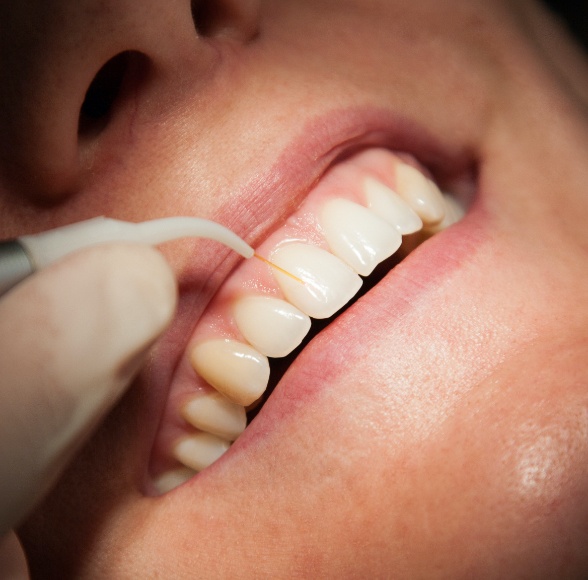
Dr. Kassem equips his dental office with the latest technology that the dental world has to offer, including a high-powered, precise soft tissue laser. Using this tool, we’re able to provide you with much-needed relief by removing infected oral tissue in a virtually pain-free and minimally invasive fashion. This highly concentrated beam of light will shorten your healing time, cause little bleeding, and allow us to preserve healthy parts of your teeth and gums.
How Laser Periodontal Treatment Works
Laser periodontal treatment is often performed in conjunction with scaling and root planing (a deep cleaning of the mouth). It is suitable for various stages of gum disease, from early infections to advanced cases.
We use the soft tissue laser to accomplish two key objectives:
- It can remove diseased tissue while preserving as much healthy tissue as possible.
- It kills bacteria, which can stop gum disease from progressing.
Following laser periodontal treatment and scaling and root planing, the gums should be able to reattach to the teeth and will be at a reduced risk of future infections.
The Benefits of Laser Periodontal Treatment
Traditional gum disease surgery is performed with a scalpel. Compared to that method, laser treatment offers some major advantages:
- The laser cauterizes tissue as it removes diseased areas. This keeps bleeding to a bare minimum and can eliminate the need for sutures.
- Laser treatment is more comfortable overall for patients.
- The bacteria-killing power of a soft tissue laser keeps the risk of post-op infections to a bare minimum.
- The laser is extremely precise, so it preserves as much healthy oral tissue as possible.
- Laser therapy comes with a lower risk of future infections than traditional gum disease treatments.
Aftercare Tips for Laser Periodontal Treatment
It can take a week or so to recover from laser periodontal treatment (compared to 2 – 4 weeks for non-laser surgeries). During that time, you may experience swelling, sensitivity, and mild discomfort. Ibuprofen or other over-the-counter medications can help with this. Eating soft foods can also be beneficial.
Oral hygiene is very important, but you should be extra gentle when you are brushing and flossing around the treated area.
We may recommend that you visit us for periodic follow-ups after your treatment so we can help you prevent new occurrences of gum disease. Of course, you are always welcome to call us if you have questions or concerns about your gum health between your appointments.




